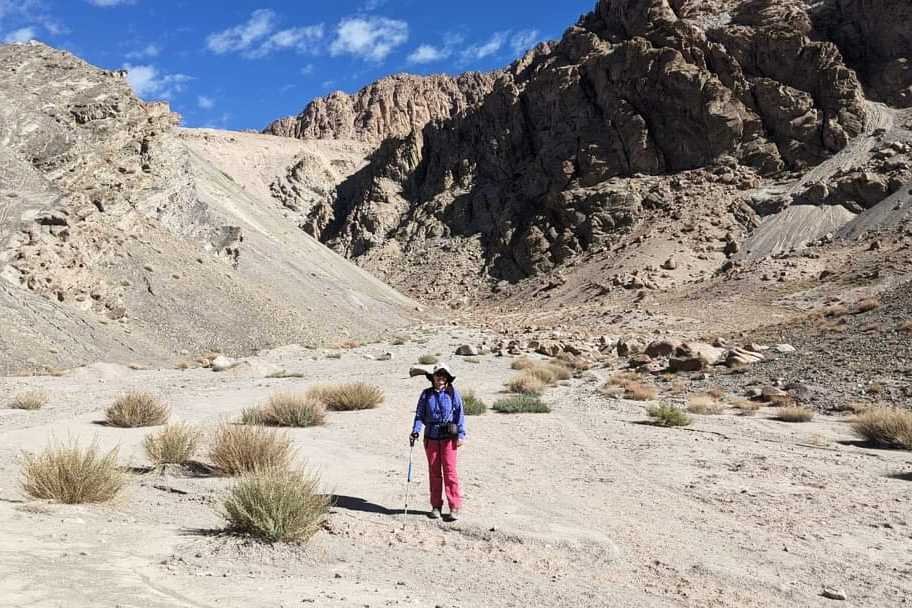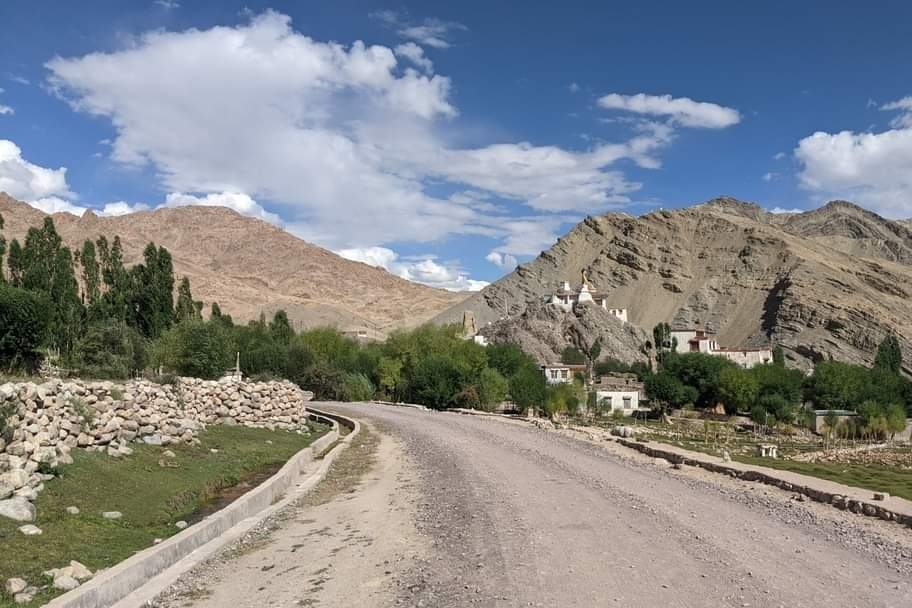- Call Us +91 9459018019
- Mail Us info@brozaadventures.com

The Sham Valley trek is one of the most beautiful and beginner friendly trek in Ladakh, with its rugged terrains and serene landscapes, offers some of the most captivating trekking experiences in India. One such trek that perfectly balances adventure with cultural immersion is the Sham Valley Trek. Nestled in the lower region of Ladakh, this trek takes you through a series of picturesque villages, lush fields, and historic monasteries, providing an authentic glimpse into the region's rich heritage and natural beauty.
Situated at an altitude of approximately 3,900 meters (12,710 feet), the Sham Valley Trek is often referred to as the "Baby Trek," making it an ideal choice for beginners and those looking for a shorter yet fulfilling trekking experience. Spanning a distance of 27 to 32 kilometers, the trek typically takes 3 to 5 days to complete, allowing trekkers to enjoy the breathtaking views and tranquil environment at a leisurely pace.
The trek traverses through vibrant barley fields, dense groves of cedar trees, and scenic apricot orchards, particularly around the village of Hemis Shukpachen. This region is home to a variety of wildlife, including blue sheep and numerous bird species, adding to the trek’s allure for nature enthusiasts.
Beyond its natural beauty, the Sham Valley Trek is a journey through Ladakh’s cultural heart. The trek passes through traditional villages such as Yangthang, Hemis Shukpachen, and Ang, where trekkers can stay in local homestays and interact with Ladakhi families, gaining insight into their daily lives and customs. The presence of ancient monasteries and religious sites along the route further enriches the cultural experience, offering a unique blend of adventure and spirituality.
Best Time to do Sham Valley Trek:
The best time to embark on the Sham Valley Trek is from June to September, when the weather is most favorable, with warm days and cool nights. However, the trek can also be undertaken in the shoulder months of May and October, depending on snowfall. Each season offers a different perspective on the landscape, from the lush greenery of summer to the serene, snow-covered vistas of early winter.
For those considering a winter trek, it is important to be prepared for colder temperatures and potential snow, which can add an extra layer of challenge and beauty to the journey. Regardless of the season, the Sham Valley Trek promises an unforgettable adventure, filled with stunning scenery, cultural richness, and the warm hospitality of Ladakh.
Whether you are a seasoned trekker or a novice looking for an accessible introduction to high-altitude trekking, the Sham Valley Trek is a perfect choice, offering a rewarding blend of natural beauty and cultural exploration.

Start your trek in Likir, after visiting the renowned Likir Monastery. The trail leads you to the Phobe La pass and then to the charming village of Sumdo. Continue your journey upward to the Chagatse La pass before descending to Yangthang village. Enjoy your first night in a local homestay.
Today’s trek takes you across the Tsermangchen La pass, offering panoramic views of the surrounding landscape. Descend towards Hemis Shukpachen, one of Ladakh's prettiest villages, surrounded by cedar trees and crisscrossed by sparkling streams. Spend the night in a welcoming homestay.
Begin your day with a climb to the Mebtak La pass, marked by prayer flags. After crossing the pass, head down to the village of Ang and continue to Temisgam. Visit the local palace and monastery built on a hillock before settling into your homestay for the night.
For those with extra time, consider extending your trek:
Q: Can I do the Sham Valley Trek without a guide?
A: Yes, the trek can be done independently, but having some trekking experience is beneficial. A guide can enhance your experience and help with navigation.
Q: What is the best time to do the Sham Valley Trek?
A: The best time is from June to September when the weather is most favorable.
Q: Is the Sham Valley Trek suitable for beginners?
A: Yes, it is considered an easy to moderate trek and is ideal for beginners, though some fitness and acclimatization are recommended.
Q: Are homestays available along the route?
A: Yes, homestays are available in the villages, offering a chance to experience local Ladakhi culture.
Q: What makes the Sham Valley Trek unique compared to other treks in Ladakh?
A: The Sham Valley Trek, often called the "Baby Trek," offers a perfect blend of cultural immersion and natural beauty. It’s unique for its comfortable homestays, interaction with local villagers, and relatively easy trails that make it accessible for beginners and families.
Q: How does the Sham Valley Trek compare in difficulty to other treks in Ladakh?
A: The Sham Valley Trek is considered one of the easiest treks in Ladakh, making it ideal for beginners and those looking for a more relaxed trekking experience. Unlike more strenuous treks like the Markha Valley or Stok Kangri, it requires less physical fitness and acclimatization.
Q: Can I bring my children on the Sham Valley Trek?
A: Yes, the trek is family-friendly and suitable for children. The daily trekking distances are manageable, and the altitude is relatively low compared to other Ladakh treks. However, it’s important to ensure that your children are fit and enjoy walking.
Q: What kind of wildlife and flora can I expect to see on the Sham Valley Trek?
A: The Sham Valley is known for its diverse flora and fauna. You might spot blue sheep, marmots, and a variety of birds. The region is also home to beautiful wildflowers and unique vegetation adapted to the high-altitude environment.
Q: How do homestays enhance the trekking experience?
A: Staying in homestays allows you to experience authentic Ladakhi culture and hospitality. You can enjoy traditional meals, learn about local customs, and interact with the villagers, making the trek not just a physical journey but a cultural one as well.
Q: What are the main attractions along the Sham Valley Trek?
A: Key attractions include the ancient monasteries such as Likir and Rizong, the scenic village of Hemis Shukpachen, and the breathtaking views from passes like Tsermangchen La and Mebtak La. Each location offers unique experiences and picturesque landscapes.
Q: How do I prepare for the altitude on the Sham Valley Trek?
A: Acclimatization is crucial. Spend at least 2-3 days in Leh before starting the trek to adjust to the altitude. Drink plenty of water, avoid alcohol, and consider taking it easy the first few days.
Q: What is the weather like during the trekking season?
A: From June to September, the weather is generally pleasant with daytime temperatures ranging from 15°C to 25°C. Nights can be cooler, so it’s important to carry warm clothing. Weather can be unpredictable, so be prepared for sudden changes.
Q: Is there a possibility of extending the trek to other regions?
A: Yes, you can extend your trek to include visits to other nearby attractions such as Alchi Monastery, Lamayuru, or even combine it with the Markha Valley Trek if you have more time and are looking for a longer adventure.
Q: How environmentally sustainable is the Sham Valley Trek?
A: The trek is designed to be environmentally sustainable. Staying in homestays reduces the impact on the environment compared to camping. Trekkers are encouraged to follow Leave No Trace principles, respect local wildlife, and minimize waste.
Q: What are the accommodation options like during the trek?
A: Accommodation is in local homestays which offer basic but comfortable facilities. You’ll get to enjoy traditional Ladakhi hospitality, home-cooked meals, and a cozy bed, making your stay both comfortable and culturally enriching.
Q: What should I pack for the Sham Valley Trek?
A: Essential items include comfortable trekking shoes, warm clothing (layers), sun protection (hat, sunglasses, sunscreen), a water bottle and purification tablets, a personal first-aid kit, trekking poles (optional but recommended), snacks and energy bars, and a backpack (20-30 liters).
Q: What kind of food is available during the trek?
A: During the trek, you will be served traditional Ladakhi meals at homestays. These meals are typically wholesome and nutritious, consisting of local dishes like thukpa (noodle soup) and tsampa (roasted barley flour).
Q: Is travel insurance necessary for the trek?
A: Yes, travel insurance is mandatory and should cover high-altitude trekking, medical emergencies, and trip cancellations or delays due to unforeseen circumstances.
Q: How safe is the Sham Valley Trek?
A: The Sham Valley Trek is considered safe for trekkers, with well-marked trails and hospitable locals. However, it's important to be prepared for high-altitude conditions and follow safety guidelines provided by your guide or trek operator.
The Sham Valley Trek is a delightful journey through the heart of Ladakh, perfect for those looking to explore the region's natural beauty and cultural richness in a short time. With its moderate difficulty and stunning scenery, it promises an unforgettable adventure for all trekkers. For more information, feel free to contact us
